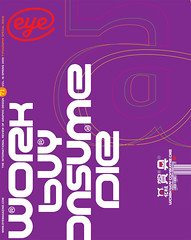Spring 2009
Risk and ritual
Anne Harild’s work offers a challenge to the unthreatening norms of British illustration
A few months ago, the Association of Illustrators sent me a copy of Images 32, which aims to offer ‘the best of British contemporary illustration 2008’. Since its return to favour at the end of the 1990s, illustration has been thriving, so it’s reasonable to expect a survey of the best work to be full of startling images, showing how a new generation is pushing the discipline forward with original, highly personal interpretations of the world. That’s not how Images 32 struck me. The primary purpose of many of the projects it shows seems to be reassurance. They offer an unthreatening fantasy world where colours are bright, simplified decorative forms ensure stress-free consumption, and the people look like characters who have escaped from a children’s picture book.
Is there a place for challenging illustration now? There is no question that this used to be possible in Britain. The period from the late 1960s to the late 1980s was an inspiring time for anyone who believed that illustration could be a channel for an uncompromising personal vision, with the arrival of committed artist / illustrators such as Stewart Mackinnon, Sue Coe (Eye no. 21 vol. 6), Terry Dowling, Andrzej Klimowski (Eye no. 14 vol. 4), Robert Mason, Anne Howeson and Dirk van Dooren. In the 1980s, Russell Mills (Eye no. 5 vol. 2) led the way in exploring the possibility of a subtly allusive, semi-abstract, almost musical form of image-making.
The case of Anne Harild, a Danish artist who exhibited in January at a temporary gallery in South Kensington, highlights the current problem. She came to London to study at Camberwell, the London College of Communication and the Royal College of Art because she was attracted by the opportunity for experimentation offered by British design education.
In 2007, she won the Oberon Books Illustration Award at the RCA with a set of eight images made in response to Don Paterson’s English versions of Rilke’s Sonnets To Orpheus. The sonnet is a highly structured type of poem and Harild’s interpretations took the form of austere metaphorical collages depicting structures and enclosures that are part architecture, part sculpture – it would be possible to build them. ‘These pictures can exist in their own right, independent of the words,’ she told Arc magazine, ‘but I still think we can call them illustrations.’
The key point for her, as for earlier experimental illustrators, was that the images should convey the emotional essence of the poem, though this is clearly a subjective matter that depends on the reader / viewer’s response to two kinds of sophisticated aesthetic experience. Yet even at this stage, while Harild was still completing her MA in Communication Art and Design, an article in Design Week questioned whether such work could be commercially viable.
Harild herself was inclined to doubt these images had a commercial future. Some of the pictures she displayed last year at her RCA degree show, in a series called Tarn [Tower], surfaced again at her ‘Assemblages’ show. For the sonnets, she took photographs of architectural elements such as pipes, railings, window frames and bricks on walks around London. From these, she cut the delicate fragments she uses to build new structures, with details and textures that always recall their source materials, while becoming totemic and strange.
The towers of Tarn feel rural and vernacular, rather than urban and architectural. Constructed from wooden poles and slats instead of brick and stone, they suggest a role in some unknown activity – a work practice or symbolic ritual. Each structure is viewed from a consistent angle against a white background, as though the images were artefacts presented for objective study in an anthropological textbook rather than imaginative works.
In the Plantage [Plantation] series, in the same show, Harild devises structural collisions between irregular pole shapes and angular sheets and grids. These numinous objects, partly inspired by a visit to a pine plantation, where the trees were in lines, feel both organic and man-made.
This is intensely private imagery and it would need to be deployed with great sensitivity to work as illustration – the most obvious uses are for literature and music. Harild is already exploring the musical possibilities in collaborations with the composers Edmund Finnis and Orlando Higginbottom. Morandi Room, an ‘animated still life’, was commissioned for the ‘MAP/making’ audiovisual event at the RCA in November 2008. As things stand, Harild seems most likely to pursue a path as a gallery-based artist and film-maker.
The dearth of challenging work in illustration is not just the medium’s loss – it’s the viewer’s. An area of applied visual communication that could be vital and extraordinary is too often childish and regressive. Commissioners of illustration need to tap into the immense talent out there and stop playing it so safe.
Rick Poynor, writer, Eye founder, research fellow, Royal College of Art, London
First published in Eye no. 71 vol. 18 2009
Eye is the world’s most beautiful and collectable graphic design journal, published quarterly for professional designers, students and anyone interested in critical, informed writing about graphic design and visual culture. It is available from all good design bookshops and online at the Eye shop, where you can buy subscriptions and single issues.

